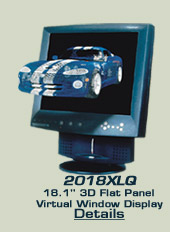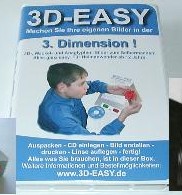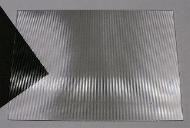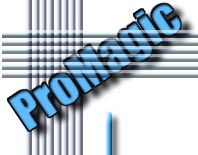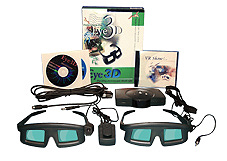3D VGA PROGRESSIVE VGA BOX - The german engineered box brings field sequential 3D-video from 3D-DVD or NuView to DLP-projectors and Plasma-TV's at up to 100Hz flicker-free.
The 3D TV SYNC- BOX brings 3D-video to 100 Hz CRT TV-sets, which are very common in Europe.
Anifest 2006 - The 'International Festival of Animated Films AniFest' held from May 4-10, 2006 in Trebon, Czechia will again present a collection of stereoscopic-3D short-films.
The IRIS-3D 2-channel autostereoscopic display offers 1600x1200 resolution per eye and according to the manufacturer there's zero ghosting.
Mission 'STEREO' (Solar Terrestrial RElations Observatory) - NASA and ESA lift the most likely largest and most expensive 3D-camera setup ever into space to get a Stereo3D-view of our sun. See, there's no substitute for real stereo shots!
Omniatec 3D-displays - the spanish company offers full resolution stereoscopic-3D workstations based on 2 flatscreens for use with polarization glasses. A very straight-forward and pragmatic approach which has some advantages over autostereo-flatscreens, i.e. resolution, freedom-of-movement, multi-user-capability and probably price. .
The new Philips 42” WOWvx 42-3D6C01 9-channel autostereoscopic display is very reminiscent of existing displays by StereoGraphics and Opticality. However it has the advantage of having a popular brand-name printed on it, which may open new markets.
The Polaris 3D-LCD displays for polarized glasses use two full-res stacked displays in a package not much thicker than a conventional LCD-display. Sizes of 10 and 17 inch are available. Displays up to 42 inch are possible.
The new Sensics piSight™ head mounted VR display delivers a staggering 150° field of view at 2200x1200 pixels per eye. The trick is to have 24 micro-displays built into the headset. I haven't dared to ask for the price yet.
April 8, 2006: Coming fall 2006: Flickering LCD-displays
Usually one of the biggest advantages of LCD-displays compared to CRT's is the absence of flicker. The LCD just changes it's state from one frame to another without 'black-phase' inbetween, like CRT's do. BenQ and Samsung now announced LCD-displays which do have a black-phase. The backlight goes off inbetween frames. The reason for this is to reduce blur. To the human eye fast motion on the screen looks sharper if there is a black-phase between frames.
Maybe it could have advantages when combining
LCD-displays with 3D-shutterglasses concerning ghosting and page-flipping
compatibility.
I wonder at which rate these screens will
flicker - they have to be faster than 75Hz, don't they? Another issue will
be synchronization. Let's assume they flicker at 120Hz, will they accept
a 120Hz input signal and keep it intact?
Source: Chip, german issue, 05/2006, page 37
Discuss this issue with others on the webboard.
April 2, 2006: Webboard updated. User-registration now obligatory.
August 29, 2005: Stereoscopic movie show at AniFest 2006 - Call for movies by Gali-3D
July 17, 2005: Internationale Funkausstellung (IFA) Berlin 2005 02.09.-07.09.2005:
At the IFA 2005, the world's largest Consumer Electronics trade fair, Fraunhofer FIRST introduces its Digital Advertising Column (3D-Litfaßsäule).
June 18, 2005: Several HMD's/VR-helmets by Cybermind, icuiti, i-O Display Systems and Liteye Systems added to the HMD-market overview chart.
June 18, 2005: This color test pattern in JPS-format (courtesy of Gali-3D) will show the ghosting produced by your 3D-hardware.
It's designed to produce terrible ghosting over a range of different colors. This test constitutes the 'worst case'. Usually it's used to demonstrate the quality of the DepthQ projector, but it can even reveal differences between shutterglasses-LCD's on CRT-monitors. If you have the nVidia stereo driver installed a simple double-click on the image will start the nVidia stereo image viewer and trigger your glasses.
June 12, 2005: Full DepthQ 3D-projector review available
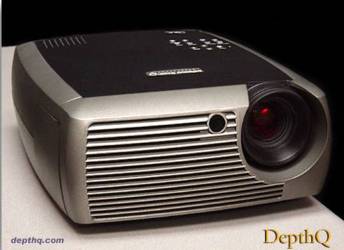
(c) InFocus/Lightspeed Design
Group DepthQ
March 31, 2005: Low cost 3D-DLP-Projection arrived!
Almost 2 years ago I urged the industry to come up with a low-cost single projector 1-chip-DLP solution. In my opinion this could in theory be the best stereo3d solution for home and office today - superior to CRT, HMD and autostereo displays. The main advantages are: virtually no ghosting, virtually no flicker, multiple viewers, large field of view, easy setup, portable, comfortable, no 2nd projector required, no non-depolarizing screen required.
Now the first product of this kind is officially available:
InFocus DepthQ™ stereoscopic, distributed by Lightspeed Design Group. www.DepthQ.com
Main specifications:
DLP, 800x600, 120Hz (real fps), 2000:1 contrast, 1600 ANSI, page-flipping-stereo3d-support for almost all PC-VGA-shutterglasses, $3,495
According to the official specifications the projector produces 'one frame delay'. As a result a stereo-reverse switch on the glasses or in the software is required, which usually is available.
The projector could also be interesting for other (2D) applications which require high frame rates. I'm not aware of any other digitial display device which can show true 120 full-frames per second.
GALI-3D has been authorized by Lightspeed Design to resell the InFocus DepthQ(tm) projector as a nonexclusive dealer for sale in the Czech Republic and other locations in Europe. In addition GALI-3D has made available a discussion board related to this device.
Also check the discussion
thread on the stereo3d.com forum.
March 26, 2005: Major update to the 'inofficial nVIDIA driver page'
March 25, 2005: Check out the 'nvidia stereo profile editor' by Mikael Gustafsson. This freeware allows you to edit and save nvidia stereo driver registry settings. On the site you can share and rate stereo settings for every game.

March 11, 2005:
New
nVIDIA
Stereo-Driver Version 71.84 officially released today! Check
here
for updated hints.
10 - 16 March 2005 Hannover,
Germany
the worlds leading computer
and telecommunications fair
CeBIT 2005: Check
this
thread for info and list of exhibitors related to Stereoscopic3D and
Virtual Reality
April 4, 2004: Interesting new 3D products and services
EST, Engineering
Systems Technologies, Germany - giant portfolio of professional VR
hardware, software and services
Lightspeed
Design Group, USA - 3D-digital-cinema equipment and services, DepthQ
server delivers 2 x 1920 x 1024
Micoy
- developed first camera capable of recording full 360 degree panospheric
stereo movies
Pavonine
Corp. - New autostereo 3D-monitors
PORRMANN
& AWATER New Media GmbH, Germany - SilverFabric
non-depolarizing screens - now offering a portable 3D-screen with 'even
surface' mechanism.
Pro
Systems Purmerend, Netherlands - VR systems rental (!) services
Virtual
Experience, Germany - 3D-movie production, 3D-DVD's
April 4, 2004: stereo3d.com email contact
My old email address bungert(at)stereo3d(dot)com and other stereo3d.com mail accounts drowned in spam. I fought it with tools and stuff, but it proved to be too time-consuming to be my own mail-server-administrator. I switched to a large web-based mail-provider.
If you sent email to the old address within the last few month and haven't got an answer, please try again under the new address. Please don't mention the new mail address anywhere on the net. Fight Spam!
18. - 24. March 2004 Hannover,
Germany
the worlds leading computer
and telecommunications fair
CeBIT 2004: List of exhibitors related to Stereoscopic3D and Virtual Reality

March 15, 2004: nVidia releases official stereoscopic 3D reference driver 56.64, check here for hints
Deutscher Raumbildtag 2003 der DGS
Deutsche Gesellschaft für Stereoskopie e.V.
(German 3D-image-day 2003
of the german stereoscopy society)
Saturday 25. Okt. 2003
9.00-23.00 h
Hugenottenhalle, Großer Saal
Frankfurter Str. 152
63263 Neu-Isenburg
Germany
www.hugenottenhalle.de
At the 'Raumbildtag' you can see high quality stereo-slides (still-pictures, polarized) on the big silver screen all day long. These guys know how to shoot in stereo and how to set up polarized projection - it won't get any better! If you want to see all slides you have to stay the whole day, there are no repeats. They just show the best of the best 3D-shots of 2003 in a row.
Usually there's also about a dozen of booth from various companies, where you can try and buy everything stereo3D-related: books, prints, slides, viewers, cameras, projectors, software, glasses, stereo-artwork, lenticulars, etc.
In the past years everyone was invited
and admission was free. It shouldn't be different this year. Keep an eye
on this page
for the upcoming detailed schedule.
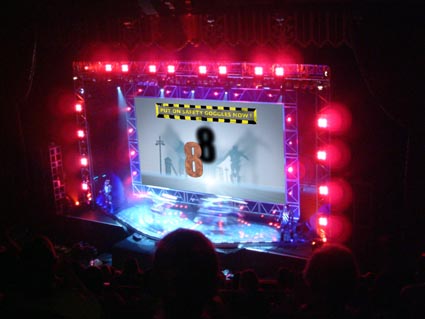
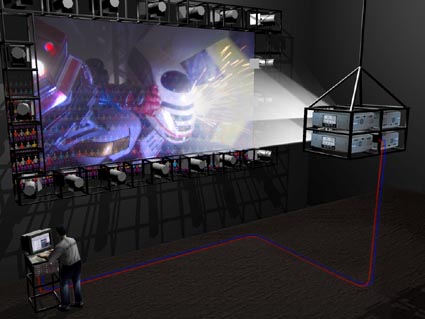
October 11, 2003: Starlight Express road show features digital 3D-projection by inition
4 UXGA 7700ANSI DLP-projectors, polarization technology. See press release.

October 11, 2003: New VR arcade machines available
Arcadian Virtual Reality, L.L.C. has purchased the rights from Cybermind UK to produce the SU2000 and SU3000 Virtuality machines. They are for sale and actually in stock now.
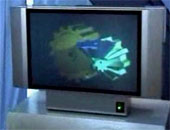
October 11, 2003: New autostereo display: HoloVizio 128W by Holografika
No glasses, no head-tracking, look-around objects, multiple users can watch simultaneously. Check out the video there.
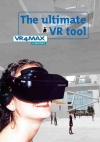
October 11, 2003: VR4MAX
VR4MAX by TREE C Technology lets you walk through your 3ds max and Autodesk VIZ models in stereo. Supports shutterglasses, headsets and lots of VR-input devices.
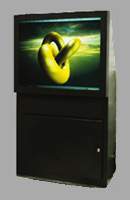
October 11, 2003: dep3D 40'' 3D-rear-projection system
utilizes 2 LCD-projectors and polarizer glasses.

September 20, 2003: digital image offers patented active dual-DLP-projector setups for shutterglasses
This solution, based on standard 1-chip-DLP-projectors and demultiplexers, offers virtually ghost-free stereo3d images at 120+ Hz refresh rates. Multi-projector arrays for CAVE's are also available. The projectors run out-of-sync to the VGA-source. The sync of the color-wheel of one of the projectors is taken and distributed to all other projectors and the shutterglasses. The internal memory of the projectors is utilized as buffer.
3D-projection
page
pleading
for single 1-chip-DLP-3D-projector
digital
image page
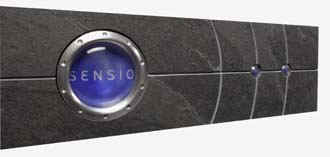
September 20, 2003: SENSIO 3D brings 3D movies to most LCD & DLP-projection based home-theatres
Sensio utilizes single standard projectors, specially formatted 3D-DVD's and 3D-shutterglasses. Please read my comments.

September 20, 2003: Lightspeed Design Group announces completion of a stereoscopic 3D motion simulator ride-film
There are lots of ride films and lots of 3D films, but the combination of both is still rare, so you may be interested in this press-release.

August 26, 2003: i-Art at IFA
i-Art Corporation
will attend the largest European Consumer Electronic Fair - IFA
2003 in Berlin, Germany.
The showtime is
from August 29th to September 3th, i-Art's booth # is Hall 4.1 No. 871.
At this tradeshow,
i-Art will present the 3D LCD monitor , 3D Photo Kiosk, Foto3D Print LE
products.
http://www.iart3d.com
http://www.i-art.com.tw
I looked for 3D-related products/companies in the IFA-catalogue, but couldn't find any, not even the mentioned i-Art products. Certainly there will be some 3D-stuff at IFA, which doesn't show up in the catalogue.

August 13, 2003:
nVidia
releases official stereoscopic 3D reference driver 45.23

August 6, 2003: X3D Technologies Corp. acquires 4D-Vision GmbH and WINx3D/VRCaddy software assets
See press release
X3D
home
4D-Vision
home
WINx3D
home
VRCaddy
home
VRStandard
home
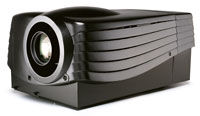
July 20, 2003: Pleading for a low-cost 1-chip-DLP active-stereoscopic-3D projector
July 20, 2003: 3D-cam on a chip
The new PMD is a single-chip stereo-3D-sensor
which can determine the distance of objects. It's expected to show up in
cars, planes, robots, machines and medical probes soon. The margin of error
in distance determination for an object 1 km away is less than 1 mm !
The actual resolution is just a few thousand
pixels, since the design goal was to detect the shape, distance and movement
of objects, rather than to deliver 3D-images. However the military has
already shown strong interest in a hi-res version which can deliver crisp
3D-images as well.
Check PMD Technologies (german) and the article in Chip issue 7/2003, page 94 (german).
July 5, 2003: Introducing the 'lenticular print software' page: Latest i-Art product reviewed, comparison chart of all lenticular software products
June 28, 2003: FAQ and 3dplus pages updated.

May 24, 2003: Awesome Stereoscopic Video Player available for free
The 'Stereoscopic Player' by Peter Wimmer accepts any stereo video input format and turns it into any common stereo3d output format.
This is the perfect solution to watch interlaced 3D-DVD's flicker-free on the PC (see instructions). The best 3D-tool in ages and it's for free - get it now!
It has a video library with settings for most 3D-DVD's and download links and settings for many 3D-videos on the net.
Problems? Well, it doesn't support page-flipping yet, so Revelator and ASUS glasses won't work.
'Stereoscopic Player' doesn't try to convert 2D to 3D like 3dplus or X3D. Although you can choose monoscopic as input format and stereo as output format this will achieve nothing. 'Stereoscopic Player' is for real 3D only!
May 24, 2003: New autostereo display technology based on DLP
There's a new kind of autostereoscopic display, developed at the University of Texas, utilizing Texas Instruments DLP (digtial light processing) MMD micro mirror device technology.
The article
doesn't reveal details on how it works. However I assume that the MMD simulates
the optical properties of a conventional hologram, i.e. light interference
patterns. It is also conceivable that the observer has to look into the
mirror (directly or via back-projection), rather than looking on a front-projection
on the wall.
March 29, 2003: New HMD technology by LINUS
The swedish company LINUS offers a new type of headset for augmented reality.
Like Microvision, LINUS also uses just one line of pixels which are turned into a seemingly complete image by a fast moving mirror in the headset. In this case however the LED- or CRT-line is placed outside the headset, fixed to the wall, ceiling, cockpit, table, seat, etc.
This may have some advantages over other HMD technologies: lower cost, less power consumption, less weight, less risk of theft, see-through vision, multiple viewers see the same image in the same place and no need to transfer the whole video signal to the headset.
The technology can also be used to create transparent, volumetric 3D images by stacking several line-displays behind each other.
I think it should also be fairly easy to
make the system stereo-capable, using the time-sequential shutter-principle.
The display-line could show page-flipped source material while the optical
system in the headset blacks-out one eye at a time. Using LED-technology
it should be ghost-free too.

March 26, 2003:nVidia reference stereo driver 43.03 for Detonator 4x.xx released - or leaked
Gainward has released what seems to be the real nVidia stereo driver for 4x-Detonators. It has a new user interface and configuration files for newer games. However some new hit games, like Unreal2, NFS6 and Splinter Cell, are missing and there are still problems with the ASUS-mode under XP.
The file isn't available on the official nVidia site yet. It only showed up on the taiwanese Gainward page, so it may not be the final version.
Download here:
Discussion threads:
forums.stereovision.net
stereo3d.com/discus
Configuration hints:

12. - 19. March 2003 Hannover,
Germany
the worlds leading computer
and telecommunications fair
CeBIT 2003:List of exhibitors who are active in the Stereoscopic3D and Virtual Reality sector.
March 17, 2003: IMAX-3D cinemas in Bochum and Frankfurt (Germany) closed
Officially they are temporarily closed, because of 'technical' difficulties. It seems more likely that these difficulties are of a financial nature. I hope this can be resolved soon.
March 16, 2003: 'Snap-a-Cam' digital 3D consumer video and photo cameras announced
Found this at snap-a-cam :
"In Q3 next year (2003?) the company will introduce a twin lens Stereo-3D digital video camera (featuring real time image capture). However before that, in late Q1 2003, Snap-a-Cam plan to start selling the world’s first consumer Stereo-3D digital camera."
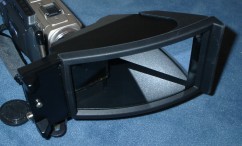
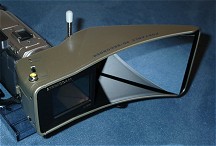
March 9, 2003: NuView (USA) vs. StereoCam (Korea) shootout
Can the Koreans turn your camcorder into a better 3D-machine for less?
Read the full review.
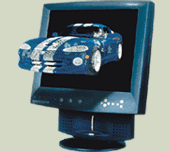
March 8, 2003: DTI 18.1 inch 2D/3D autostereo display clearance sale
Dimension
Technologies, today announced a dramatic, limited-time inventory clearance
price on its popular 2018XLC 18.1" 2D/3D switchable display.
The 18.1" 2D/3D switchable display, previously
priced at $4995, is available for only $3495 each! Quantity discounts are
available.
The XLC seems to be the predecessor of the XLQ. Both are identical, but the XLC has no video-input, just VGA. The XLQ comes at $5995. So this looks like an interesting deal. If you need 3d-video get a stereo-capable line-doubler (like Maxx3D).

March 5, 2003: New version of VRCaddyXP released.
Trial version available here. VRCaddyXP is a stereoscopic game driver for most VGA-boards and most 3D-shutterglasses. However the main focus of the developers seems to be on ATI boards and VRStandard glasses.

March 4, 2003:
Stereoscopic
"3D Consortium" for autostereo displays founded today by Sony, Sanyo, Itochu,
NTT Data and Sharp!
Kodak, Microsoft, Olympus and about
60 others are joining the club
Official
3D Consortium site (japanese)
Sony
press release
Heise
News (german)
Gamefront
(german)
Business
Week
NewsWireless
(Sharp presents phone with stereoscopic display)
Thanks to Martin of stereovision.net for the hint
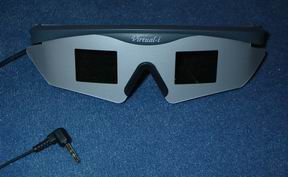
The new VNM Virtual-i shutterglasses use thin-film-plastic-LCD's rather than glass.
Feb. 19, 2003: Plastic for President? VNM Virtual-i review
Just when you thought there can be no more surprises on the 3d-shutterglasses market...
The glasses? Just 27 grams! The controller? Better than the former No.1! The price? Consumer-level!
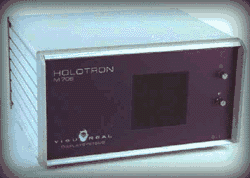
Feb. 19, 2003: Holotron on sale
The development of the Holotron autostereo monitor by Visureal continues. The 6" model is actually on sale now. Models with larger screen-sizes exist as prototypes. Main applications are in medicine (e.g. 3D-ultrasound-analysis) and science. Unfortunately I haven't seen it yet, but reportedly it's the most stunning look-around-autostereo-display.

Feb. 9, 2003: Scuba Diving 3D by Virtual-Adventure
400 new ultra-hi-res stereoscopic images on 2 CD's, from the creators of 'Flower Power' - reviewed

Feb. 9, 2003:
3
new 3D-DVD reviews added to the DVD-page
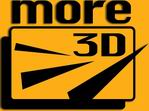
January 19, 2003: more3D - professional universal stereo-driver for dual-VGA-output
more3D is a universal driver which creates stereo3D from most Direct3D (OpenGL announced) games or applications and delivers two VGA-signals from a dual-head nVidia VGA board. The signals can be used to drive a dual-projector setup, dual-input HMD's or dual-input autostereo-displays.
In other words you'll save the money for an expensive VGA-demultiplexer and prevent all the instabilities which can happen with software page-flipping. The more3D driver can also be adapted for multi-channel-autostereo displays, such as 4D-Vision 4D, StereoGraphics SynthaGram or Philips 3D-LCD.
System requirements for a 3D-projection system: more3D, nVidia GeForce 4 Ti 4600 with dual-VGA-output, Intel P4 1.7GHz or better, WinXP, two identical projectors, polarizing filters, polarizing glasses, non-depolarizing silver screen.
more3D is based in Cologne, Germany and was founded in 2001 by a group of former ELSA stereo3D experts. more3D is for professionals only. According to a spokesman the new driver wasn't derived from the Revelator or nVidia driver, but developed from scratch.
January 12, 2003: Dimension Technologies Inc. wins NASA 2002 Small Business Innovation Research contract - Press release
December 4, 2002: 3D-Movie list updated
December 4, 2002: Looking for news and info on Stereo3D and VR in russian language? - Check out Vladimir Simtchenko's Virtual & Really.ru
December 4, 2002: DTI autostereo displays available for demonstration and purchase at selected CompUSA stores
December 4, 2002: Press release: Cyviz releases SXGA stereo projection system
December 4, 2002: Press release: New version of StarStrider stereoscopic planetarium software
September 27, 2002: Press release: New Sharp autostereo display. Sharp works toward establishment of 3D display consortium
September 15, 2002: photokina - world of imaging 2002
September 25.-30., 2002 Köln (Cologne), Germany
3D-Exhibitors:
- 4D-Vision GmbH - autostereo monitors - hall 14.2, booth P051
- ANSMANN GMBH ACCU-TECHNIK Deutschland - 3D-cameras - 03.1 N059
- China Film Equipment Corp. China - 3D-cameras - 09.2 M030
- Christie Digital Systems Inc. - 3D-projectors - Großbritannien 14.1 B010
- Colour Town (HK) Ltd. Hongkong - equipment for digital 3D-photography - 09.1 B021
- Cyviz VGA-Stereo-Projection-Demultiplexers - hall 14.2, booth # P030/P038
- DGS - Deutsche Gesellschaft für Stereoskopie - hall 1, booth D 35
- Dr. Clauss Bild- und Datentechnik GmbH Deutschland - 3D-cameras - 10.2 V052
- Dr. Gilde System-Kamera-Technologie GmbH Deutschland - 3D-cameras - 10.2 U038A
- EDU-Toy's GmbH i. G. Deutschland - 3D-cameras - 03.1 P054
- Galaxy Optical Asia Ltd. Hongkong - 3D-cameras - 03.1 L061
- ideesign GmbH Deutschland - equipment for digital 3D-photography - 10.2 W033
- Keyphoto Limited Großbritannien - 3D-cameras - 03.1 L006 / M006
- Konrida Industrial Ltd. King Yip Factory Building Hongkong - 3D-cameras - 03.1 L061
- Lang Audio & Medientechnik Deutschland - 3D-projection - 14.1 F060
- Loreo Asia Ltd. - 3D-cameras - hall 03.1, booth L061
- Lumens Technology, Inc. Taiwan - 3D-cameras - 14.1 G041
- MCS Werbeagentur GmbH Deutschland - 3D-projection - 10.2 U021
- Minolta Europe GmbH Deutschland - 3D-cameras - 01.2 01.2 G001 G002 / G018
- projectiondesign Norwegen - 3D-projectors - 14.1 F059
- QPcard AB Schweden - 3D-cameras - 11.1 09.1 E067 F005
- scannova GmbH Deutschland - equipment for digital 3D-photography - 10.2 M010
- Seagull Digital & Image Co., Ltd., Shanghai China - 3D-cameras - 02.1 K020
- Shanghai Shenhao Professional Camera Co., Ltd. Rm. 1404, No. 2, Lane 721 China - 3D-cameras - 02.1 K020
- Tohkai Sangyo Co., Ltd. - stereo viewers - hall 01.1, booth C049
- Vitro Laser GmbH Deutschland - 3D-cameras - 09.1 E015
- VIVITAR (Europe) Ltd. Suite 6, Cherry Orchard West Großbritannien - 3D-cameras - 03.1 01.2 L006 / M006 F050
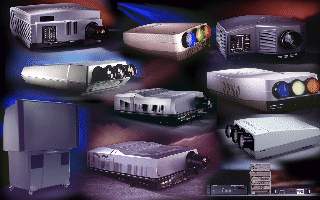
August 18, 2002: BARCO: new 3D projection webpage and brochure
New
BARCO stereo pages
New
BARCO stereo brochure PDF 1.3 MByte
August 18, 2002: ASUS Deluxe VGA boards - modified onboard glasses-controller design
The ASUS Deluxe-line of nVidia based VGA-boards features an on-board shutterglasses-controller. In the past (at least up to model V6600) the controller was always active, making it possible to use 3rd party page-flipping drivers (3rd party interlace drivers may work). In the new design (at least since model V84x0) the controller is only active with the original ASUS drivers installed. With the nVidia reference graphics & stereo drivers the glasses remain dead. The only theoretical solution would be to use the nVidia drivers in ASUS-mode (execute regedit.exe, search for 'StereoViewerType' and select '2' instead of '0'). This mode never worked for me, but you may have more luck. Please give some feedback on the webboard.
If you own an older ASUS Deluxe board with 'always-active' controller and use the nVidia reference stereo driver in standard mode you should be aware that you may end up in reversed-stereo-mode (left eye sees right image and vice versa) which is very bad. There is no reverse hotkey in the nVidia driver, so you would have to hit stereo on/off hot-key until you catch the right direction. You should better stay with the ASUS-driver or try the ASUS-mode of the nVidia driver.
Check my old configuration hints for the nVidia drivers, which are still valid.
August 18, 2002: nVidia reference graphics driver 30.82 & stereo driver 30.82 officially released

August 18, 2002: RAZOR3D INKS DEAL TO PRODUCE TWENTY 3D DVD MOVIES
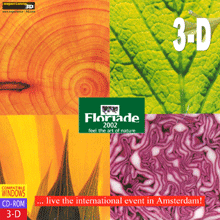
August 18, 2002: Experience 3D releases two new 3D-CD-ROM titles:
Floriade Exhibition 2002 and Santorini Volcanic Island. Images are in hi-res JPS-format.
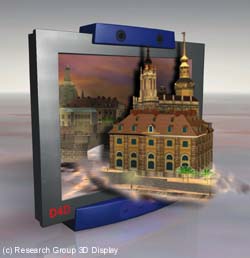
August 18, 2002: Dresden 3D is now i2i
On April 10, 2002 the Dresden
3D GmbH, developer of the D4D Autostereo Display, filed insolvency
(inability to pay).
In June they found a new investor from
Denmark. The activities of Dresden 3D were taken over by i2i GmbH (“eye-to-eye”).
See my short review of the D4D from Cebit 2000.
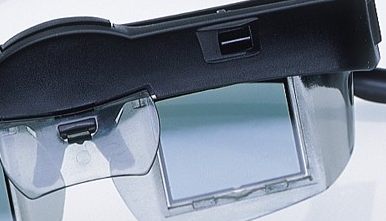
August 18, 2002: What remains of ELSA
The ELSA AG as a joint-stock company is definetely out of business. The creditors won't see much of their money, since there's not enough substance left. ELSA was famous in the stereoscopy community for their Revelator glasses, which were manufactured by Ilixco. The glasses design and control mechanism lives on in H3D/i-glasses, eDimensional and other OEM glasses-products. Revelator receives continued support via the nVidia reference graphics&stereo drivers as well as the WINx3D drivers. They are also compliant to the VESA mini DIN-3 connector standard and as such can be used with professional graphics-hardware.
ELSA-Japan will continue to exist as a division of TJC. ELSA-Lancom products will be distributed and supported by the new Lancom Systems. Data-communication products were taken over by the new Devolo AG.
There are investors who plan to found a new company which will use the brand-name 'ELSA' and who will concentrate on the computer-graphics and multimedia market.
August 18, 2002: Breider Moore & Co. Acquires SENSE8 product line from Unigraphics Solutions, Inc.
13. - 20. March 2002 Hannover,
Germany
the worlds leading computer
and telecommunications fair
March 13, 2002: CeBIT 2002: List of exhibitors who are active in the Stereoscopic3D and Virtual Reality sector.
March 13, 2002: ELSA joins CeBIT
Despite their financial problems ELSA is present at CeBIT Hall 11 Stand D50. They will show at least their Ecomo4D autostereo screen with new software. Don't know about Revelator.
February 27, 2002 : ELSA filed insolvency
According to Heise-News ELSA finally filed insolvency (legal inability to pay), but there is hope that the company will be saved. They may also come up with an emergency plan for the CeBIT.
February 23, 2002 : Stereoscope Applet Version 2.0 released
Stereoscope Applet is a freeware tool for publishing stereo images on the web in a very convenient way.
"The advantage of Stereoscope Applet is that you only have to prepare a JPS file or two separate left/right images and the applet does the rest (calculation of anaglyphs, interlaced, above-below and so on...) "
Stereoscope Applet 2.0 press release
February 23, 2002 : ELSA in trouble
ELSA the distributor of the Revelator 3D-shutterglasses and the Ecomo 4D autostereo screen is in financial trouble. They may have to legaly file for 'inability to pay' in the near future. ELSA also cancelled it's participation for this years CeBIT, although a very expensive booth was already prepared.
The Revelator is now available for extremely low prices in germany. Some wired Revelators were spotted for as low as 5 Euros.
The Revelator glasses are manufactured by Ilixco. Various versions of the glasses are distributed under the iO-Display/i-glasses and various other brands. Most versions for the PC are Revelator compatible, i.e. they listen to the Revelator trigger signal on the VGA-port. Revelator and compatibles receive continued driver support by nVidia and the Win3D Company. There are also solutions for Linux. So the technology will survive in any case.
What set the ELSA Revelator solution apart was the excellent stereo quality of the glasses-driver, with their DynaZ technology and graphical on screen display. Further development on the driver seems to have ended some time ago, but the drivers by nVidia, ASUS, VR-Standard and Wicked3D haven't reached the standard set by ELSA yet. Only problem were the resource conflicts which troubled the ELSA software page-flipping technology.
The ELSA Ecomo 4D autostereo screen is in fact a relabeled 'D4D' by the Dresden3D GmbH who will continue to manufacture and distribute their product.
February 23, 2002 : i-CONE stereoscopic 230°-panoramic screen at CeBIT
The Fraunhofer
institutes will be present at CeBIT with several new
VR-technologies, including the i-CONE
stereo panoramic projection screen
with 5.760 x 1.320 resolution. According
to the CeBIT floor plan i-CONE has
a diameter of 8m.
Other VR-technologies shown at the Fraunhofer
booths (Hall 11 Stand A14 +
A10) are augmented reality (with laser
display), 3D assemble table, virtual
showcase, portable 3D-laser-scanner and
more.
February 23, 2002 : More consumer VGA-boards with bundled shutterglasses
ASUS gets some competition in the field. Products by MSI, Gainward and Colourpower (page not up yet) / Club3D now come with bundled glasses. MSI and Gainward use nVidia chips (and presumably the nVidia stereo driver) as a basis. Colourpower uses SIS chips. While Gainward and Colourpower have an onboard glasses connector, the MSI comes with an add-on board.

February 23, 2002 : MicroVision presents prototype of new LED-based miniature color SVGA display - press release
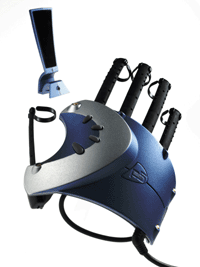
February 23, 2002 : Looking for some low cost VR-gloves? Check out the Essential Reality P5
![]()
February 19, 2002 : ASUS stereo driver for WinXP available
![]()
February 3, 2002 : Flower Power released
The Virtual-Adventure Flower Power 3D CD's are now available. (See News-item of Dec. 22.) The final release has 1001 JPS stereo images in hi-hi-res. The price is 27 Euro or 25 US$ as expected.

Jan. 4, 2002: 3dplus 2D-to-3D conversion video player updated
The VideoCD (MPEG 1) version is now available in an enhanced version (1.0.1106). According to the developers the stereo-algorithms were enhanced. They claim that non-horizontal movements are now handled better and even used in the generation of stereo effects. A DVD (MPEG 2) version is scheduled for February.

Jan. 4, 2002: VRCaddyXP released!
The stereo-game driver by VRStandard is now availble in a Windows 2000/XP version. It's free for registered VR-Joy users. Supports all sync-doubler and line-blanker shutterglasses. No page-flipping yet. Most major VGA-chipsets are supported, including ATI, Matrox, nVidia and 3dfx.

Jan. 4, 2002: VRex releases new version of DepthCharge, the stereo image and video plugin for IExplorer and Netscape

Jan. 4, 2002: StereoVision.net is back online!
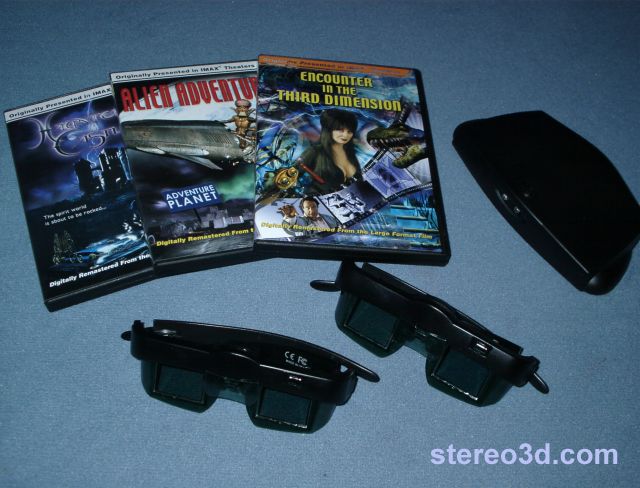
Jan 2, 2002: 3D-DVD's reviewed !
Jan 1, 2002: Happy new year
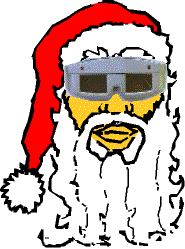
Dec. 24, 2001: Merry 3DX-Mas

December 24, 2001 :I've copied this from the webboard (click here for thread), since it seems very important for the Linux community and because Michal asked me to:
HW Stereo emulation wrapper library for Linux by Flavio Villanustre
"I've developed a small emulation layer that could allow running unmodified hardware based stereo binary only applications without quadbuffering drivers under linux. It converts hw based stereo into interlaced mode stereo that can be seen with standard LCD glasses.
It fools binaries into thinking that hw stereo is available while translates it into interlaced mode stereo using stencils. I works for many glut based stereo applications (I've placed some test utilities on my website). There's no performance penalty. Just download it from http://geminis.myip.org, compile it using: "gcc -o interlace_preload.so interlace_preload.c -shared" and use it as a preload library with: "LD_PRELOAD=./interlace_preload.so application params"
Please, send me your feedback"
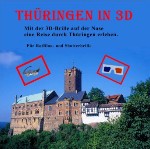

December 22, 2001 : Thuringia in 3D by Digital-3D-Media
This title contains over 200 stereo-photos
shot in Thuringia, Germany. The stereo-quality is well above average. The
graphical user interface provides a guided tour with informations and music.
Each image comes in 4 different formats: 2D, red-blue-color-anaglyph, alternate-line
(interlace) and JPS too. You have to leave the user interface to view the
JPS seperately though. The image resolution is 794x520@24bit color (JPS
has 1588x520).
There are seperate german and english
versions of the CD which comes for 17,90 Euro.

![]()
December 22, 2001 : You're looking for extreme high-res, high-quality stereo-photos for the PC? Check this out.
Virtual-Adventure Flower Power 3D: 1000 stereo-photos on 2 CD's, resolution up to 1280x1024 per eye (i.e. 2560x1024 32bit color JPS). All images seem to have a vertical resolution of 1024, just the width may vary. Perfect for all shutterglasses supporting page-flipping. Works for the Revelator-viewer, nVidia-viewer and WINx3D+3DPix. Actually it comes with a slideshow-script for 3DPix and fitting MP3-music.
The product will be released in January 2002 at an expected price of 27,- Euro (about 25 US$).

December 15, 2001 : Finally stereo-gaming for Windows 2000 & XP is here. Get the reference graphics and stereo drivers for Win 95/98/Me/2000/XP from nVidia.
Check out my comments and configuration hints on the nVidia driver (an older article, but still valid).
If you use Win2000 on a non-nVidia board
you may check out Wicked3D eyeScream
light/Pro (OpenGL only) and WINx3D
(applications only).
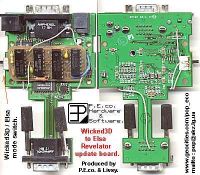
Make H3D Revelator/nVidia compatible
December 15, 2001 : Here's a great homebrew project page for making the classic H3D/Wicked3D glasses Revelator-compatible and as such fit for the nVidia reference stereo driver.

December 15, 2001
:
It's not so often our fellow Linux/Unix stereo users get something
to chew on, but here it is:
white_dune
a graphical VRML97 Editor and animation tool in development.
Stereoscopic is only supported via "quadbuffer",
it has been tested with
- SGI IRIX Indigo2/Impact and Crystal
Eyes glases
- PC Linux Matrox G400 with XIG Xserver
and 3D Revelator glasses
Many thanks to MUFTI
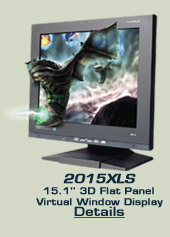 Win it!
Win it!
October 13, 2001 : DTI autostereoscopic 3D-LCD-display sweepstakes
Press release:Dimension Technologies Inc., generally regarded as the world leader in real depth 3D displays and holder of many of the world's major patents on 2D/3D switchable LCD Displays, today announced a sweepstakes to win a DTI 15" 3D LCD Display.
The contest, which begins on October 4th, is based at the company's web site at www.dti3d.com, and is open to all residents of the United States 18 and older with a valid email address. Merely visit the site and fill in the short entry form.
According to Arnie Lagergren, DTI President, "we are giving away one of our original pre-production units. We built a very small number of these models and most of them were used as demonstration and evaluation models loaned to webmasters and magazine editors so they could review this amazing new technology for their readers. Only a literal handful of this model were ever sold. So the one we are giving away is truly a collector's item. DTI displays are the world's only commercially available 2D/3D LCD Displays."
Even though it is a pre-production model, the unit being given away will be fully functional and will display images in real depth 3D. Additional details are available on DTI's web site at www.dti3d.com.
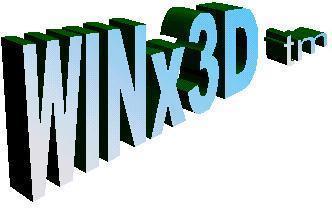 v3.20
v3.20
October 13, 2001 :The Win3D company has just released version 3.20 of WINx3D - the stereoscopic library for Windows. Significant upgrades in this release include support for two-monitor displays, for GeForce 3's, for Kyro's, for DirectX8 specific applications, and new options for anaglyph glasses.
You can get the updated drivers and a software development kit at www.win3d.com
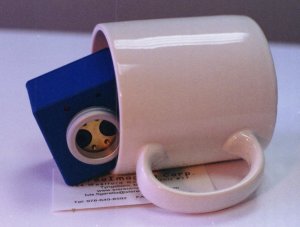
October 13, 2001 : Miniature stereo-video-cameras now available from www.stereoimaging.com. The cameras have a built in multiplexer, so the output is either dual full video (one per channel), or field sequential stereo.
October 13, 2001 : Check out this new project: www.trizax.com
Cybernarium
October 13, 2001 : Virtual Reality Theme Park planned for 2004
Cybernarium is a project by the Fraunhofer-IGD in Darmstadt, Germany and will most likely be located in the Rhein-Main-area in Germany. The project doesn't seem to be finally greenlighted yet though. The concept includes a 3D-museum, all kinds of 3D/VR-presentations, Cyberdome with 360° interactive projection for up to 150 spectators, shop with all kinds of 3D/VR-products for sale, conference rooms and a service company which supports 3rd parties with VR-know-how.
The Cybernarium website is available in english and german.

July 21, 2001 : Get the bugfixed version of the 3dplus user manual! 3Dplus manual PDF (1.8 MB). The older versions had some font-problems.


July 15, 2001 : SSC 3dplus 2D to stereo3D MPEG1 (VCD) realtime video converter - free trial version available
3Dplus
player trial v1.0.0429 (3.6 MB)
3Dplus
manual PDF (1.8 MB) (new bugfixed version! -
July 21st)
demo
MPEG (5.1 MB) (right click
and choose 'save target')
System requirements:
- PIII 550 MHz or better
- 128 MB
- Windows 98/Me/2000
- DirectX
- sync-doubler-shutterglasses for over-under format (e.g. 3dplus-bundled glasses, i-Art Eye3D, i-glasses-H3D, NuVision 60GX-NSR, StereoGraphics with EPC, ...)
- MPEG2 (DVD) support with complete set of 8 conversion algorithms (current version has only 3): October 2001 (confirmed)
- Page-flipping support: October 2001 (according to manual)
- Official SSC website (korean only ?)
- Official SSC 3dplus website (temporarily down ?)
- Official soft4D website (english/korean)
- my review of 3dplus ver. 1.0.0401
- join the discussion on the stereo3d.com webboard

June 30, 2001 : i-Art products in Latin America
3eradimension.com offers i-Art Eye3D products on the latin american market.

June 30, 2001 : DTI Dimension Technologies Inc.: new 15" autostereoscopic display and incredible price drops
At DTI
an 18" LCD autostereo display now comes for $6,999 and the new 15" model
at just $1,699. There is even talk about an additional $200 rebate. Two
years ago the price was $13,949 for the 18" and $8,649 for the earlier
15" model. So autostereoscopy starts coming out of the lab and into our
homes.
The DTI autostereo displays support all
common stereo-formats (4-in-1), so they'll work with virtually any stereo-applications,
-images, -animations and universal stereo drivers, including official support
for the new NVidia reference stereo-driver.
I had no chance to try the DTI products yet. Please read my short report about the D4D/ELSA autostereoscopic display which uses similar technology, but is more expensive, has DVI-connection and supports only one stereo-format.
Also check these reviews:
about.com
- a well done review, lots of background info, compares autostereoscopy
to other technologies, comes to the conclusion that shutterglasses are
superior for gaming.
3dhardware.net
- the 15" model gained an Editor’s Choice Award there, discusses many aspects
including ghosting

June 30, 2001 :
Digi
Art launched the latest version of their stereoscopic lenticular printing
software: LENTICULAR 2.0d. The company also offers pre-printing services
for professional lenticular products.
The program is available in english
and german, support is granted in english, german an spanish.
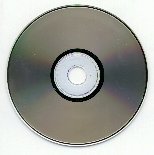
Finally - 3D-DVD
June 30, 2001 : Slingshot to release IMAX-3D titles by nWave on 3D-DVD for TV-shutterglasses
It seems they use the same standard-TV-interlace-format
as common 3D-VHS tapes. If this is the case it implies the common problems:
heavy flicker, incompatibility with 100/120Hz TV-sets, cut-in-half-resolution,
incompatibility with PC-shutterglasses (unless someone comes up with a
software-DVD player which handles and translates the format). There will
be bundles with hardware by i-glasses.
The DVD's will include also flat-versions and in one case an anaglyph version.
Check the April 27th press release on the Slingshot
page. The feature film "Parasite" (with Demi Moore) will be released
on 3D-DVD sometime in 2002 by another distributor. Many thanks to Jim Krisvoy
for the news.
APEC
June 18, 2001 :
APEC,
- Artificial Parallax Electronics Corp., developer of stereoscopic
products and supplier of the ASUS-glasses hardware announces two new products:
the 3D-Laser-Projector
and the 3D-Arcade-Machine.

June 18, 2001 : digital IMAGE, developer and manufacturer of personal imersive systems, launched new SXGA projection system with stereo-converter! PRESS RELEASE

June 13, 2001 : NVidia stereoscopic reference driver officially released. Links and info. Board and glasses compatibility information. Read how to configure the driver for your board and glasses!
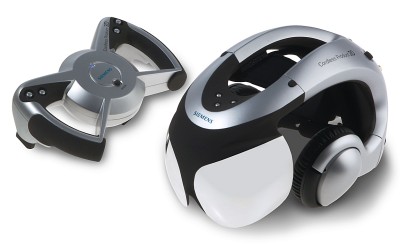
June 13, 2001 : Siemens Wireless Stereoscopic Headset - first impressions
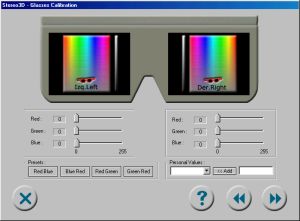
June 13, 2001 : Estereo3D® 2.0 anaglyph image tool by Alexis Naranjo available for free! Supports lots of formats, got a nice user-interface and comes in english and spanish versions. Download

June 13, 2001 :
Check
out the ARVIKA augmented reality project
by industry heavyweights, such as Audi, Daimler-Chrysler, Siemens, Volkswagen,
Ford and EADS (European Aeronautic Defence and Space Company).
The goal is to develop systems which
merge the users view with context-related virtual content using see-through
headsets.
June 13, 2001 : The new VRStandard VRCaddyPro universal stereo game-driver, along with the latest release of WINx3D now allows full-resolution page-flipping on most VGA-boards.
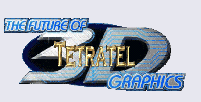
June 13, 2001 :
Tetratel
was granted the US patent on the so-called 'line-blanking'
technology for shutterglasses controllers.
Until now Tetratel had the patent for
Canada, while US patents were pending. Tetratel also developed and patented
a 3D Laser Projection Technology (LPT) which has the ability to project
objects into air without the need for glasses and will have full 360 degree
viewing.
May 13, 2001 : Finally the 4DSoft 3Dplus 2D-to-3D MPEG-1 video converter review

May 6, 2001 : VRStandard VRJoy 2000 reviewed


April 28, 2001 : Wicked3D eyeSCREAM light retail version reviewed.
Play any OpenGL game in stereoscopic 3D with inexpensive red-blue cardboard glasses!
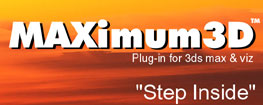
April 28, 2001 : Interactive Imaging Systems, Inc. (IIS) announced the release of its MAXimum3D software plug-in for Discreet’s ® 3D Studio Max® and Autodesk® 3D Studio Viz®. MAXimum3D is a real-time rendering engine for use within 3D Studio MAX. Check the Press Release
The plug-in allows non-technical users to create interactive, realtime walk-throughs of their work without programming. A free evaluation copy is available for download.
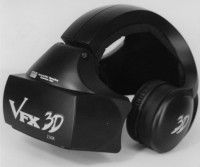
IIS is best known for their VFX-1 and VFX3D VR-headsets. The new software doesn't require any special VR hardware, but supports stereoscopy and headtracking on the VFX3D

April 26, 2001 :
SSC
3Dplus and i-Art Eye3D Force reviewed
April 10, 2001 : Problem with Discussion Board fixed.
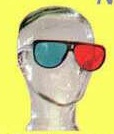
April 5, 2001 : E3D Media Group now sells 'E3D Super-Anaglyph Glasses' (with special red/cyan color formula & diopter correction) U.S. Patent pending. E3D is offering free samples to ALL anaglyph site owners.

April 5, 2001 : Wicked3D released an anaglyph version (for red-blue/red-cyan glasses) of their famous universal game driver. It's called eyeSCREAM light and should work for most common VGA-boards. There is a free demo, which works for Quake3 and 4x4 Evolution only. The full version works for most games and costs around $15.
Let's hope this will give more people a taste of things and boost shutterglasses sales.


April 2, 2001 : Michal Husak, master of Stereo-OpenGL, has released a new page with sample codes and demos for stereo and headtracking on the VFX3D. The stereo stuff also works for shutterglasses.

April 2, 2001 : CeBIT 2001 - Unfortunately I wasn't there this year. You can find great CeBIT coverage with lots of photos at StereoVision.net .

March 18, 2001 :
CeBIT
2001 Worlds No.1 Business Fair for Office Automation, Information Technology
and Telecommunications - Hannover, Germany, 22. - 28. March 2001
- 9:00 a.m. to 6:00 p.m
List
of stereoscopy and virtual reality related exhibitors
 TOP 10
TOP 10
March 18, 2001 : The Best Buy page now has a Shutterglasses Top 10 - I guess that's what everybody waited for.
The Top10 already covers the new SSC 3dplus, the Eye3D Force and the VRJoy2000. Full reviews of these products will be available soon.
March 7, 2001: VRCaddy - new version - 15 day free trial available for download
VRCaddyMe by VR-Standard is a universal game driver for shutterglasses under Win 95/98/ME. The latest version supports most 3D-VGA boards and lots of different shutterglasses, including:
VRJoy, ELSA Revelator, H3D, VRex VR-Surfer, 60GX-NSR, ASUS, Eye3D, Another I's, APEC, I/O-Display-Terminator/Cruiser, Tetratel, SimulEyes, Fanatix, etc.
There are seperate versions for interlace
and for page-flipping. The full version is free for registered VR-Joy users,
for all others it's just US$ 15.

Feb. 25, 2001: Check out the 3D-DLP-XGA projector by VRex. It supports polarization- and shutterglasses.

Feb. 24, 2001: Volan Design shows a concept for a self-contained, DataPlay-driven VR-headset. German newspaper Welt am Sonntag claimed in their Feb. 18 issue this thing will be stereo3d-capable and available soon. I think this is very very unlikely.
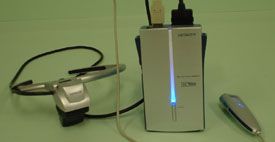
Hitachi WIA headset
Feb. 24, 2001: Hitachi, Shimadzu, Colorado MicroDisplay, and Xybernaut cooperate for Wearable Internet Appliances - see press release
Feb. 24, 2001: Another I's (TV) review updated, PAL support available


Feb. 15, 2001: Another I's (TV) for 3D-video reviewed!
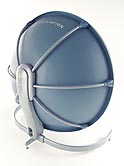
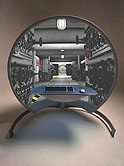
Jan 20, 2001: ElumensVisionstation brings 180° projection to the desktop - read comment


Jan 20, 2001: Eye3D
Premium and AnotherEyes2000 available
in Germany
Jan 20, 2001: International version of 3D-Easy in english language available now (also see news-item of Dec. 19)

Jan 20, 2001: The Win3D company - www.win3d.com - has just released version 3.0 of WINx3D. This version adds stereoscopic support for Windows NT and 2000. WINx3D applications can now run on Windows 95 to Me and Windows NT to 2000.
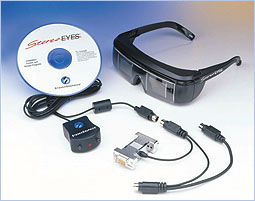
Jan 20, 2001: StereoGraphics introduces StereoEyes for the professional PC-user - read comment
Dec 19, 2000: New software kits for lenticular autostereoscopic 3D-images and animated images
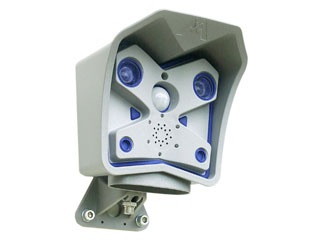
Dec 19, 2000: Mobotix - Internet-Vision-Systems offers an outdoor digital video camera with stereoscopic option. The camera works as a stand-alone webserver with Ethernet and ISDN interfaces. An ideal solution for a true 3D-webcam at a reasonable price starting at around $500.
Dec 10, 2000: Eye3D 4-in-1 Premium review is ready - Best system of all time?
Nov 19, 2000: CHRISTIE DIGITAL ANNOUNCES WORLD’S FIRST STEREOSCOPIC 3-D DLP PROJECTOR
Thanks to Michael and Greg for the News
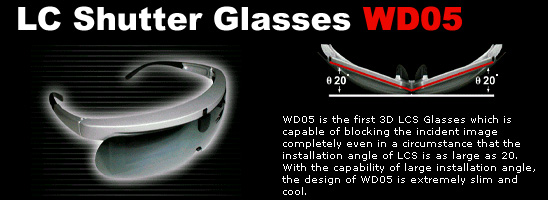
Nov 5, 2000: APEC announces WD05 shutterglasses
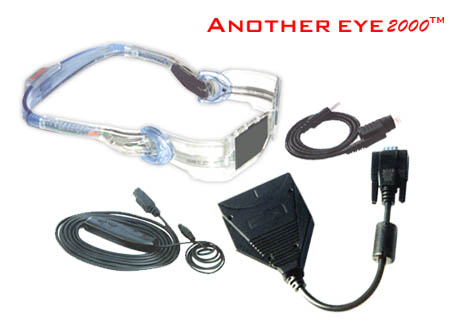
Nov 5, 2000: Highest compatibility ever! Another Eye2000 by Another World is here! - check the stereo3d.com review and enjoy tons of hi-res images and the pro & con roundup

Nov 5, 2000: XGaming.com at Comdex Fall, new 3D products, special prices on 3D glasses (with Wicked3D). Special offer for stereo3d.com readers!

Nov 5, 2000: Cyberworld Online announcement - prizes to win

Nov 5, 2000:
i-glasses
3D PC swimsuit video Press
Release

Oct. 8, 2000:
If
you're looking for an universal 3D-image tool, check 3D-Combine.
Supports all kinds of glasses, all major image-formats, batch conversion,
AVI-video and even the ELSA Revelator. Shareware.

Oct. 3, 2000: Check my short review of the new i-Art Eye3D PCI. Pro & Con, hints, detailed images.

Oct. 3, 2000: I know you couldn't wait any longer. So here it is: A a very preliminary version of the Unofficial VFX3D Page.
Oct. 1, 2000: The Another Eye2000 by Another World is announced for a mid-October release. Looks cool and so do the specs: Page-Flipping, Line-Blanking and Sync-Doubling!!! All with manual control. The system is wired and comes complete with Wicked3D driver.
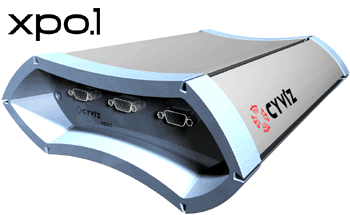
Sept. 29, 2000: Here's the one some of you waited for desperately: a VGA-level stereo demultiplexer which turns a single page-flipping signal into two VGA-streams for two polarized projectors or dual-input-HMDs: the CYVIZ xpo.1
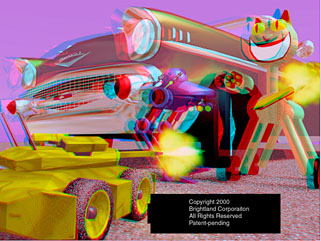
Sept. 29, 2000: Brightland introduced a new red-blue color anaglyph 3D-process called Akumira(TM). It offers real color perception. The quality is very good. According to Brightland their process is superior to even the latest full color anaglyphs from other sources. --> Brightland Press Release.

Sept. 2, 2000: i-O Display Systems H3D-Terminator, H3D-Cruiser and next generation Universal-H3D tested
Preliminary review page available.
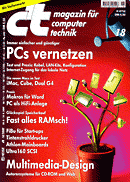
August 26, 2000: c't issue 18/00 is out now. Check my review of the latest StereoGraphics Z-Screen model 2000i in german language. An online review in english will follow later.
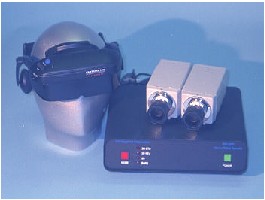
August 26, 2000:New Stereo3D-Video products by 3-D ImageTek Corp.
3D-Video
Encoder: turns two video signals into one field-sequential signal for
HMD's or VCR's
3D-Video
Decoder: turns one field-sequential signal into two video signals for
dual projector setups or dual-input HMD's
3D-Video
Encoder/Decoder: both functions in one unit
3DI
TELEJECTOR™: Decoder and two pre-polarized projectors in one rack
Click links for PDF-documents
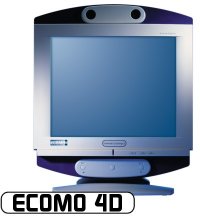
August 19, 2000: ELSA introduces Ecomo 4D, an autostereoscopic digital 18'' LCD-screen.
It's based on the D4D by the "Technische Universität Dresden". See my CeBIT report on the D4D here. The price for the ELSA model which is bundled with a professional digital VGA-board is over 25,000 Euro. ELSA hopes to cut the price considerably in the future. The target is to come in at just double the price of a comparable 2D-LCD screen within the next 2 years.
August 19, 2000: Stereo pioneer Seton Rochwite dies at age 95

August 19, 2000: i-Art introduces Eye3D-3-in-1-Wired
The new product comes
with the Metabyte Wicked3D game driver software. Advantage: about half
the price of the wireless version. Disadvantage: no line-blanking. Even
without the line-blanker it still should be one of the most versatile products
on the market.
Check the review
of the wireless version as a reference.
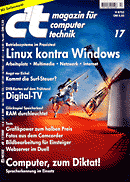
August 13, 2000: c't 17/00 contains my one page review of VFX3D in german language. Online review in english follows later. Issue 18 will presumably feature my Z-Screen review.
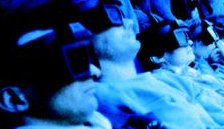
July 20, 2000: 3D-Moviechart updated

Terminator (wired version)
July 20, 2000: i-O Display Systems H3D-Terminator review available at Gamer's Pulse .
Stereo3d.com's own
reviews of the Terminatorand
it's brother Cruiser
are in the works.
The Terminator
is basically a sync-doubler system and utilizes the Metabyte Wicked3D eyeSCREAM
drivers.
The Cruiser
is supposed to be ELSA Revelator compatible (via DDC-trigger) and in addition
has a manual control line-blanker. It supports any line-sequential stereoscopic
3D-images, animations, games and applications.
Both products are
powered via the VGA-port (5V on pin 9). Some boards don't provide power,
but i-O may offer alternate external power sources.

July 20, 2000: Beta
release of Wicked3D eyeSCREAM 4.01 available
for download - now supports Voodoo5 and GeForce2.
There's still a
copy protection, so an original CD by metabyte or it's liscensees (i-Art,
i-O Display Systems, etc.) must be present during installation.
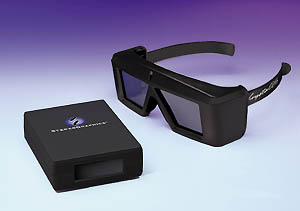
July 20, 2000: StereoGraphics introduces CrystalEyes3
June 25, 2000: They did it! ASUS Direct3D-stereo-driver breakthrough! (New: review updated July 5)
Earlier News: 1st Half of 2000
2nd Half of 1999
1st Half of 1999
2nd Half of 1998
1st Half of 1998
1997

